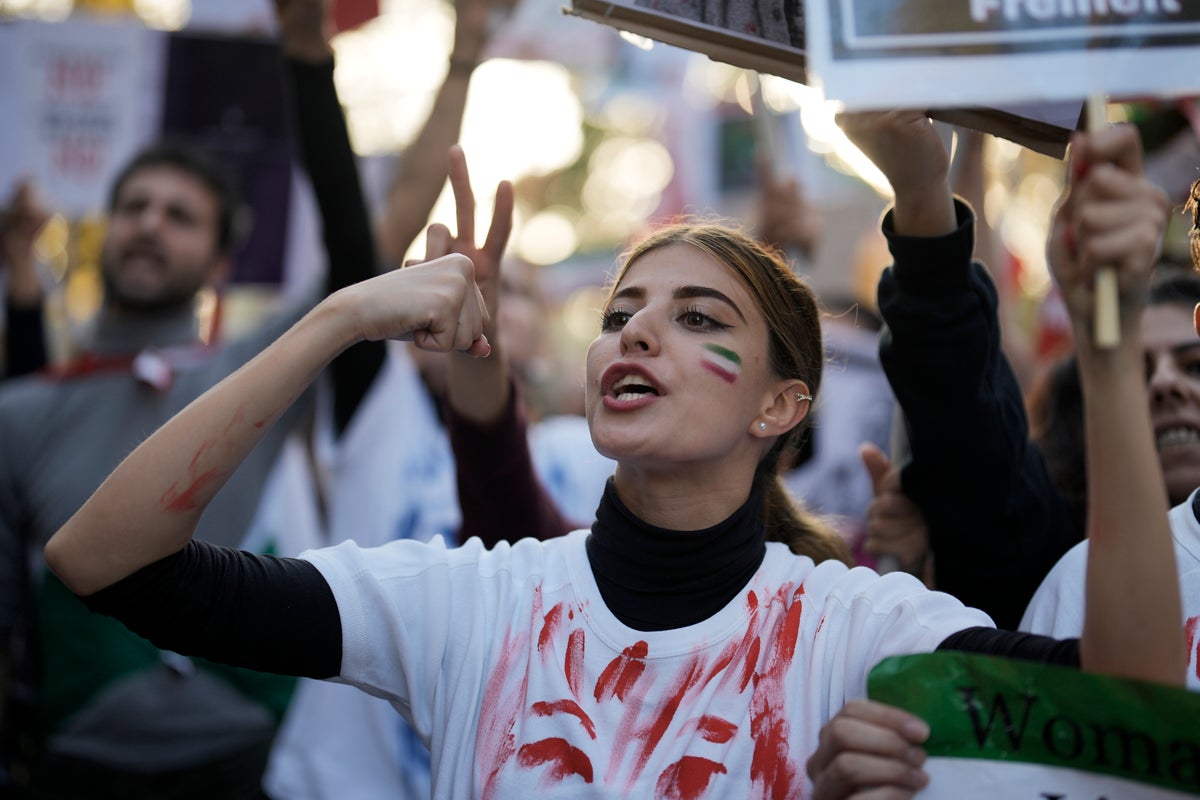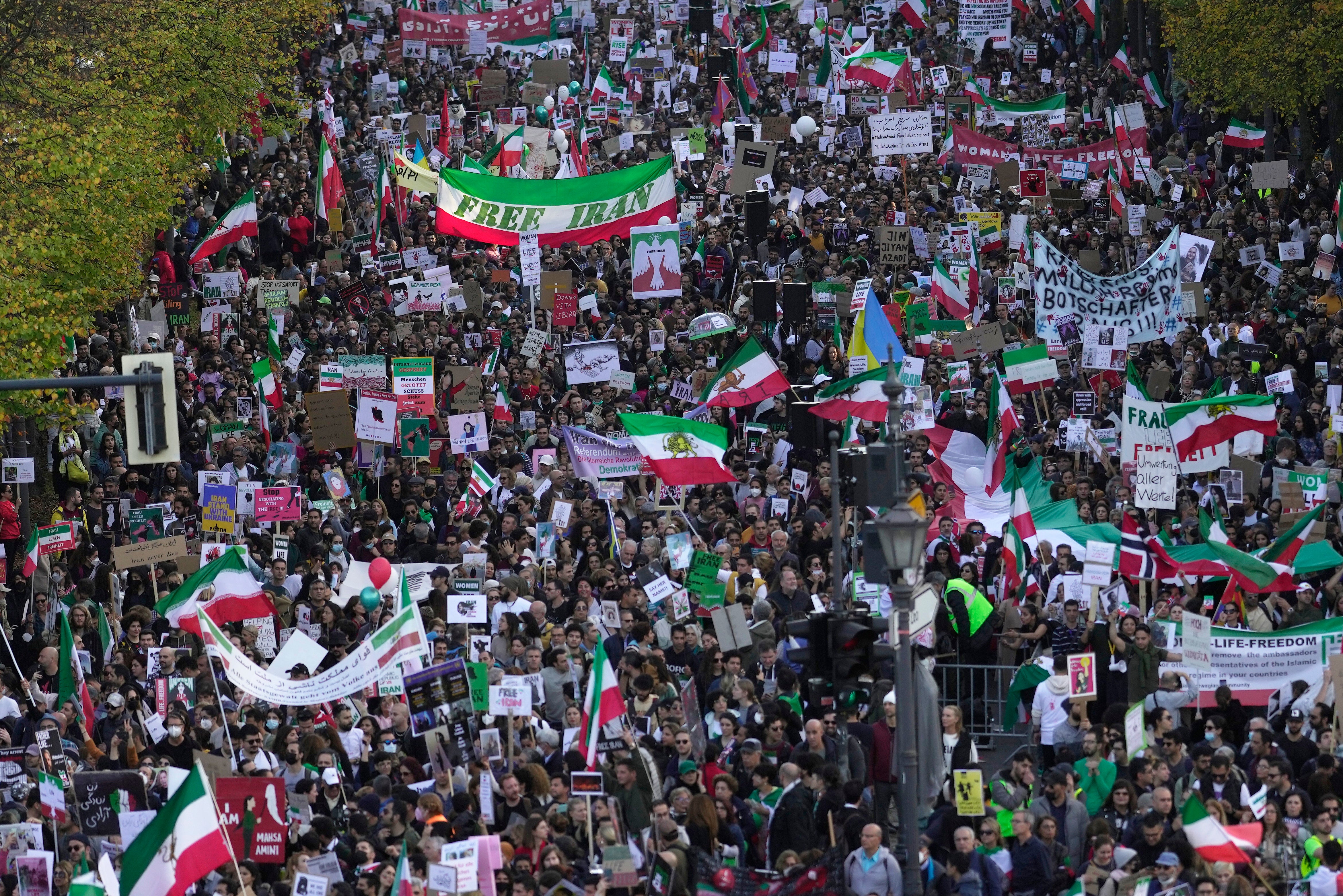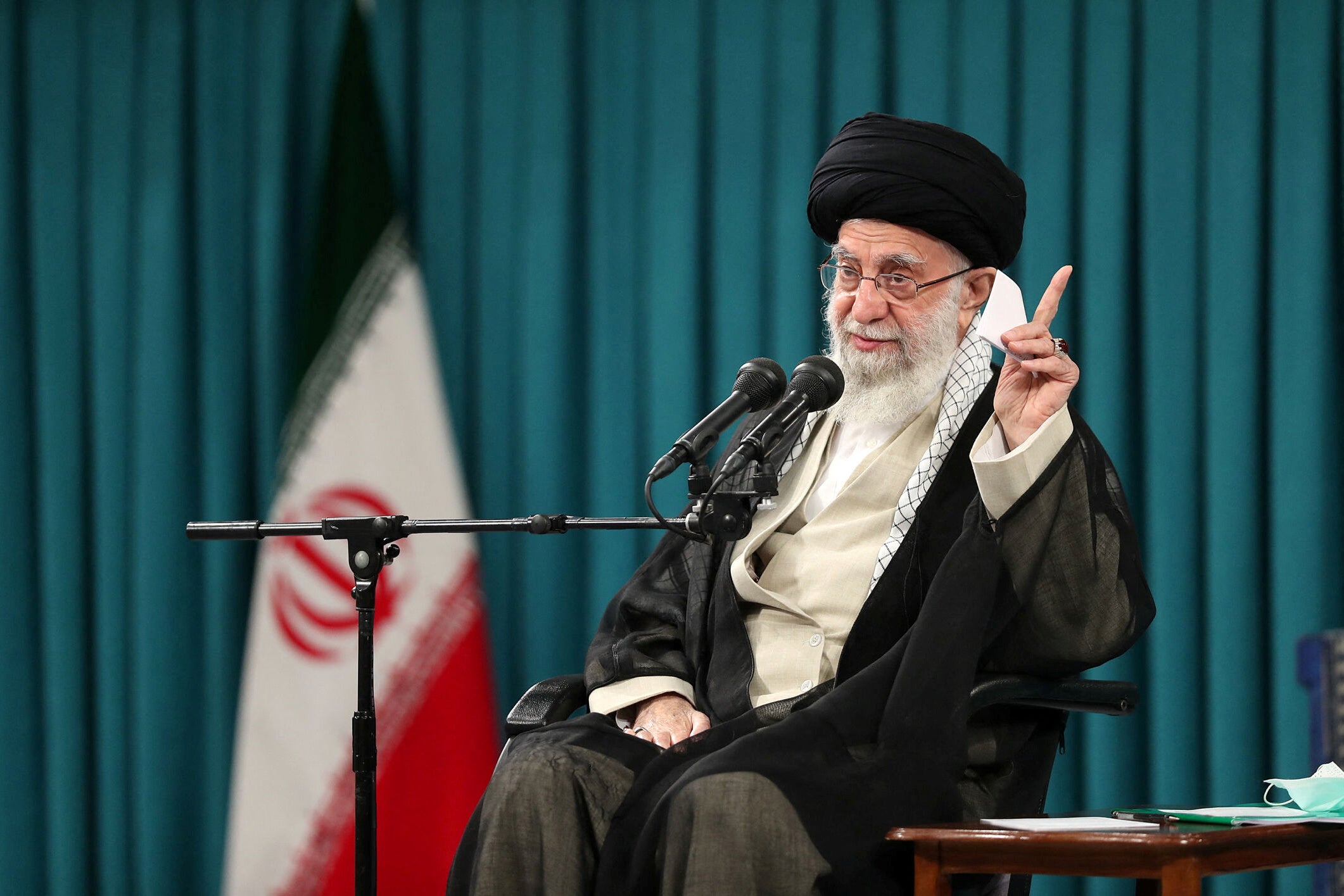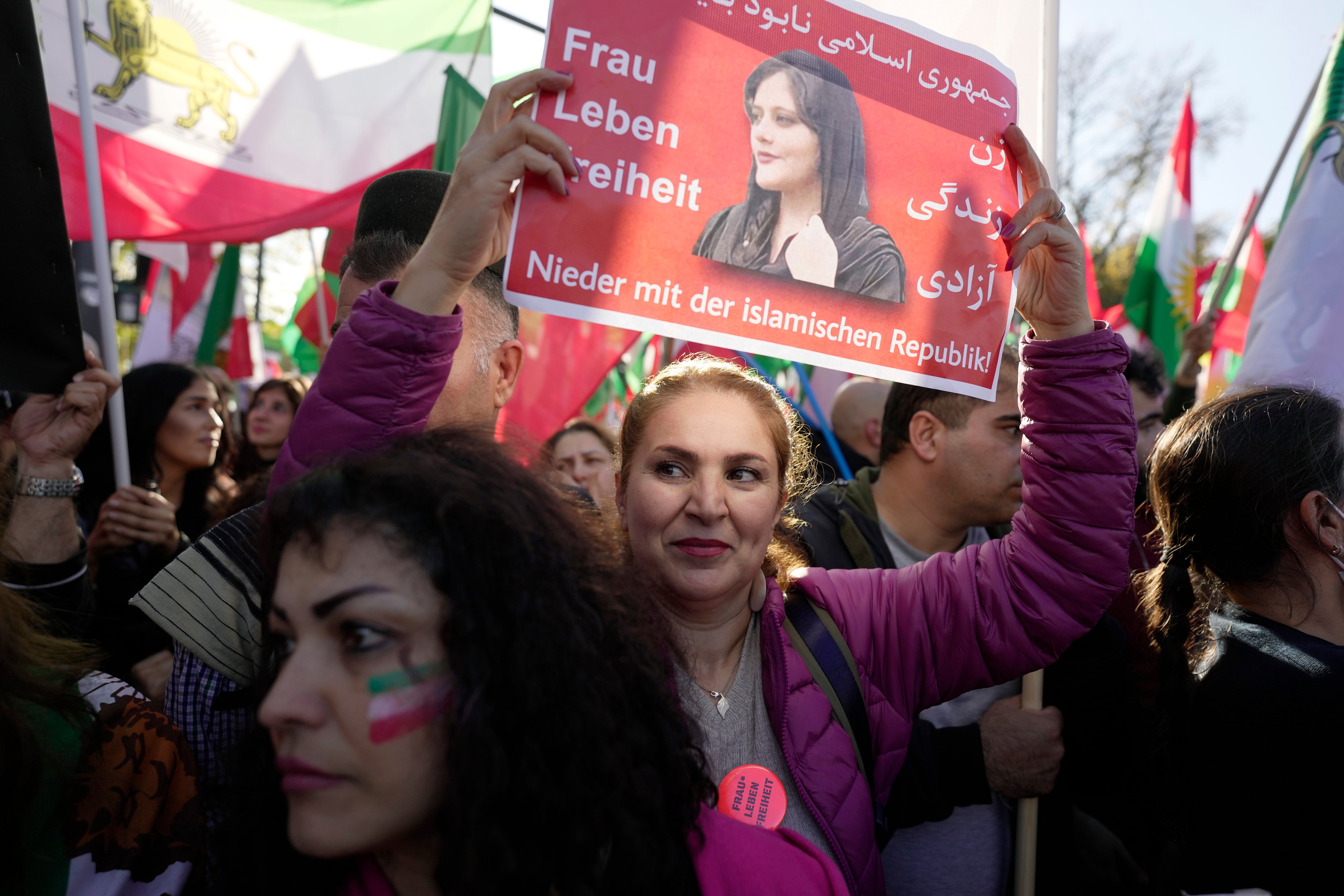
Iran’s long fragmented and dispersed opposition has begun unifying ranks against Tehran’s clerical regime and outlining a vision for the country amid weeks of anti-government protests sparked by the death in custody of a 22-year-old woman accused of violating the country’s Islamic modesty rules.
On Saturday, as many as 100,000 Iranians of a multitude of political leanings and ethnic origins gathered in central Berlin for a rare show of unity against the 43-year rule of the Tehran regime. It followed a 20 October Washington press conference by Reza Pahlavi, eldest son of Iran’s last monarch, who called for unity and the formation of a plan to replace the Islamic Republic with a transitional government. Earlier, a group of activists in Iran issued a proposed charter that would guide a possible post-regime Iran toward elections.
“We all have dreams. In our dream prisoners are not sentenced to death in three-minute trials,” Hamed Esmaeilion, the Iranian-Canadian activist who organised the Berlin event, said in a speech on Saturday.
“In this dream, the oppressors are not putting chains around the neck of writers and poets. In this dream no one dares to suppress the minorities, or to imprison a worker because of his writings, or beating and then torturing him to death.”
The regime of supreme leader Ali Khamenei remains firmly in control of Iran’s plethora of overlapping security forces and has shown ruthless resolve to remain in power. At least 248 protesters, including 33 juveniles, have been killed at the hands of the regime and at least 12,575 arrested, according to Hrana, an Iranian human rights network.
Deep rifts remain between Iran’s monarchists, leftists and liberals, between the nationalists and ethnic minorities who have borne the brunt of the regime’s repression for decades. There remain disconnects between Iranians inside the country, who lived through the traumas of the Iran-Iraq war during the first rocky decade of the Islamic Republic, and those more vocal members of the diaspora, mostly in the West, who have sometimes not stepped foot in the country they claim to represent.
But the protest movement triggered by the death of Mahsa Amini has augured unprecedented unity.
It is among the gravest challenges to the regime since it was established in 1979. Protesters take to the streets daily. Universities have become hotbeds of anti-regime activity, including on Monday, when protests erupted at a number of campuses.
In an extraordinary confrontation captured on video on Sunday, pro-regime Basiji paramilitaries claiming to be students barricaded the canteen at Tehran’s elite Sharif University to prevent female and male students from dining together in violation of Islamic rules. The opposition students pushed their way through the barricades, took control of the space and began chanting anti-government slogans. It was unclear whether they ever had a chance to dine.
On Sunday the regime announced plans to post military officers on campuses in an apparent attempt to intimidate students. High schools have also been hit by protests, and on Saturday teachers announced a nationwide strike.

Industrial action has also hit Iranian commerce, including in retail and food production, and on the periphery of the petrochemical and oil industries.
Street protests, though mostly small, are expanding geographically, and rattling a regime obsessed with maintaining control. A resident of an ultra-conservative Tehran neighbourhood said that he had spotted anti-regime graffiti on walls and heard night-time anti-regime slogans shouted from rooftops in his district for the first time late last week, and had even spotted a small protest gathering.
Videos show women flouting hijab rules in public spaces, including in parks and on public transport.
Experts say that in an environment that many Iranians inside the country and abroad see as potentially a prelude to the Tehran regime’s demise, there is an attempt to avoid what many regard as key mistakes in the run-up to Iran’s overthrow of Shah Mohammad Reza Pahlavi and subsequent establishment of the modern world’s first theocracy by Ayatollah Ruhollah Khomeini in 1979.
“Nobody wanted to ask any hard questions about what kind of regime would follow the shah because there was this sense that asking those kinds of questions might open up the divisions amongst the opposition to the shah and for the sake of unity,” said Roham Alvandi, a historian specialising in Iran at the London School of Economics.
“People overlooked all of that and just focused on the immediate goal of toppling the shah. There is certainly a determination now not to repeat that mistake of the past, to actually try to have an open discussion about what kind of system would replace the Islamic Republic.”
Mr Esmaeilion, a dentist and blogger who lost his wife and daughter after the Revolutionary Guards shot down Ukrainian Airways flight 752 in 2020, apparently mistaking it for an incoming American missile, has emerged as a leader of the fragmented opposition. He captivated the tens of thousands of protesters in the German capital.
He described an Iran in which “teachers, workers, filmmakers and activists are not in prison”, where no one shoots down passenger planes, or abducts journalists or kills protesters in the streets.
“In this dream, wind will blow through women’s hair,” he said.

Mr Pahlavi, 61, is the most well-known Iranian opposition figurehead and even some opposed to monarchy have suggested as a leader of a possible transition period. At a press conference on Thursday, he called for a unified transitional authority with the aim of leading to a constituent assembly, and urged members of the armed forces now fighting in the streets against Iranians to defect.
“We must get united so that pro-democracy forces open dialogue with the world,” he said. “An interim government should take measures such as guaranteeing people’s freedoms and rights, securing people’s livelihood, regulating foreign policy to ensure Iran’s interests, and holding a referendum.”
In Tehran, a small group of intellectuals and longtime activists who requested anonymity, in consultation with scholars and jurists, assembled a nine-point charter that describes the formation of a two-year transitional council with the aim of managing the country’s affairs ahead of forming democratic, secular and inclusive government.
“We have been trying to find a way out of the worsening political impasse, stagnant economy, violation of basic freedoms and backward culture,” a member of the group said in response to emailed questions.
“A massive amount of people power has been released that must be harnessed to effect change. We believe that the government will continue to do what it has always done at times like this: ignore the will of the people. In order to prevent bloodshed and instability, we are trying to prepare for what is to come.”
Up until recent weeks Western intelligence and diplomatic services had very little confidence that any domestic challenge could bring an end to the Iranian regime. Even now there are few signs of an imminent collapse, such as defections in the armed forces.
But experts say the regime’s pillars of support have steadily eroded as the country has changed demographically and its economy has faltered. The weeks of protest and mass civil disobedience following the death of Amini have been unprecedented.
“When you speak to people at home and at work, it is patently obvious that the state has lost all legitimacy,” said a Tehran activist involved in the drafting of the charter. “The genie cannot be put back into the bottle, and they know it. The only thing that keeps them in power is sheer use of force. You can hardly drive 50 metres down any street without seeing anti-government graffiti on the walls or women flouting the dress code. The geographical distribution is wider than anything this country has ever experienced.”

In live discussion forums on the apps Clubhouse and Twitter Spaces, Iranians abroad and those inside who manage to evade the regime’s internet restrictions have been urging fellow opponents to focus their attention on helping those on the streets and presenting a common front. They talk about coming up with strategies to get money and resources to the protesters. They discuss the benefits and drawbacks of violent resistance. They debate strategies to get the so-called “grey” layers of society who are on the fence about protesting to join the ranks of the opposition.
“Let’s put the flags aside,” said one speaker in an online forum, in response to worries about incessant squabbling within the opposition. “Let’s put the factional debates aside. Let’s show the world that we are unified, calm and mature.”







